Abstract
This study aims to explore the impact of different fibers on the explosive spalling resistance, residual compressive strength, residual flexural tensile strength, and mass loss of self-compacting concrete (SCC) after heating to elevated temperatures. The fiber types, fiber contents, and target temperatures are selected as the tested variables. Steel fibers (SF), polypropylene fibers (PF), and their combination are used to improve the fire resistance of SCC. Then, the specimens are tested after exposure to different target temperatures varying from 200 °C to 1000 °C and cooling down to room temperature naturally. The obtained results reveal that PF can effectively prevent explosive spalling in the SCC. Moreover, it was found that the temperature of 400 °C is a critical temperature for the residual compressive strength of fiber-reinforced SCC. Regarding the flexural tensile strength, the temperature of 200 °C was found to be a changing point of the SCC after heating to elevated temperatures. A sharp decrease in the compressive strength is observed when the target temperature exceeds 400 °C. For temperatures below 400 °C, the compressive strength is enhanced slightly with the increase of the target temperature. Moreover, incorporating a fiber cocktail is an effective way to improve the explosive spalling resistance and residual mechanical properties in the case of fire. Finally, the regression analysis was performed and the proposed correlations between the residual strengths and elevated temperatures are compared with equations in the literature. Good accuracy of the proposed correlation is achieved for fiber-reinforced SCC.
1. Introduction
Self-compacting concrete (SCC) is a novel high-performance concrete (HPC) with superior characteristics. Studies show that SCC can spread easily under its weight into tight and congested areas without segregating or bleeding while achieving good consolidation [1]. Considering the high workability and high durability of SCC, it has been widely used in tunnels and other underground structures [2,3,4,5]. Compared with conventional concretes, SCC is usually prepared with lower water-to-binder ratios and higher amounts of filler materials [6,7,8]. Generally, SCC has low porosity and high resistance to permeability. Despite these advantages, SCC is susceptible to spalling under fire conditions. This shortcoming mainly originates from the relatively low permeability and dense matrix of SCC [9,10,11]. Accordingly, the main challenge that confines the application of SCC is to improve the resistance time of the concrete structure in the case of fire. This issue is of significant importance to increase the structure safety in catastrophic accidents and maintain the protective properties of SCC.
Spalling is commonly characterized by the fierce or non-fierce breaking off of layers of concrete from the structure surface when it is exposed to abruptly rising temperatures, which is a normal condition in fires [12]. Based on the destruction mechanism, the spalling phenomenon can be primarily divided into four categories, including corner, aggregate, surface, and explosive spalling. It should be indicated that explosive spalling is the most severe spalling mechanism, which usually takes place fiercely and significantly degrades the material properties. Further investigations reveal that concrete spalling is a complex phenomenon which is affected by numerous factors such as concrete strength, moisture content, porosity, density, heating rate, and fiber reinforcement [13,14,15]. It is worth noting that the two most common reasons for the spalling of concrete at high temperatures are enhanced pore pressure build-up originating from the vaporization of the free and chemically bound water as well as thermal stresses originating from high-temperature gradients along with the concrete depth [16,17,18].
The performed investigations demonstrate that polypropylene fibers (PF) can effectively prevent HPC spalling at high temperatures [19,20,21,22]. This mainly originates from the PF melting when the temperature inside the concrete exceeds 165–173 °C. In this case, the vapor pressure inside the concrete can be released via the inter-connected space, which appears after the PF melting. In this regard, Liu et al. [22] showed that for the same water-to-binder ratio, similar porosity and pore size distribution can be obtained in HPC. Accordingly, PF can be used in SCC to improve the spalling resistance in case of fire. This idea has been studied and verified [23,24,25]. In this regard, EC2 [26] recommends that adding 2 kg/m3 of PF to the concrete effectively reduces the spalling. Further investigations reveal that lower amounts of PF, such as 0.05–0.15% by volume, are also effective in increasing the concrete resistance to high temperature spalling [20].
The fire resistance of the concrete is not only highly resistant to the spalling phenomenon, but it also maintains high residual mechanical properties after heating to elevated temperatures. Sideris and Manita [24] carried out experiments on six SCC mixtures with different concrete strengths and PF amounts. The obtained results showed that high-strength SCC is more prone to spalling, while the addition of PF effectively prevents high-temperature spalling. However, it was found that the mechanical properties of the concrete deteriorate after the inclusion of PF in SCC. It is concluded that it is not a good idea to enhance the fire resistance of SCC by adding PF only.
Previous studies [27,28] have demonstrated that the addition of steel fibers (SF) can improve many properties of concrete, including tensile strength, impact resistance, energy absorption capacity, and crack propagation resistance. Moreover, in the case of fire, a more uniform temperature distribution can be achieved inside the concrete with the inclusion of randomly distributed SF. This mainly originates from the high thermal conductivity of SF (28~50 W/mK) compared with that of the concrete (1.1~1.3 W/mK) [29,30]. Accordingly, stress gradients originating from abrupt temperature variations are reduced, thereby preventing the spalling phenomenon in the concrete structure [31]. It should be indicated that with the incorporation of SF in the concrete, both the spalling resistance and residual mechanical properties such as residual compressive strength, residual tensile strength, and residual elastic modulus improve. This is because SF can bridge and retard the crack propagation in the concrete subjected to fire heating [32,33,34,35]. Studies approve this analysis and show that SF’s inclusion in the concrete protects the inner structure from direct damage in the case of fire. However, this protective effect appears only when the tensile forces over a crack can be sufficiently transferred through the heated fibers. On the other hand, fibers are heated severely so that their tensile strength decreases significantly and the protection cannot be fulfilled effectively.
It should be indicated that a single type of fiber or a combination of different types of fibers can be used to reinforce the SCC. More specifically, the cocktail fiber in concrete has a positive hybrid effect on the concrete performance so that it has attracted many scholars. It is worth noting that each fiber operates as a complement to cover the weaknesses of other fibers within the concrete matrix [36,37,38,39]. Reviewing the literature indicates that there is not in-depth knowledge about the performance of hybrid fibers combined with SF and PF [40,41]. The performed investigations in this issue reveal that the presence of fibers increases the tensile strength and the porosity, thereby reducing the fire-induced spalling in SCC. Moreover, hybrid fibers improve the residual mechanical attributes of SCC and increase the concrete resistance to explosive spalling originating from high temperatures [42,43,44,45,46]. Hou et al. [41] carried out experiments on four reinforced reactive powder concrete (RPC) beams and, accordingly, studied the flexural behavior when three sides were exposed to fire. The obtained results showed that adding 2% SF and 0.2% PF by volume is an effective way to increase the resistance of reinforced RPC beams to fire-induced spalling.
Although studies show that the incorporation of PF in concrete can significantly prevent fire-induced spalling, the influence of PF on the residual mechanical characteristics of the concrete has not been determined yet. In this regard, Pliya et al. [46] showed that the incorporation of PF in HPC does not have a considerable impact on the residual mechanical properties of the concrete after heating to 600 °C. On the other hand, they found that the inclusion of 1 kg/m3 PF in HPC significantly improved the residual splitting strength and residual compressive strength when the concrete was exposed to temperatures up to 300 °C. Ding et al. [29] studied the influence of various fibers on the residual compressive strength, flexural tensile strength and flexural toughness of SCC after heating to different target temperatures (300 °C, 600 °C, and 900 °C). The obtained results showed that although the inclusion of PF significantly prevents fire-induced spalling in SCC, there is no clear rule about the residual mechanical properties of SCC.
In the present work, it is intended to investigate the influence of various fibers on the spalling resistance, residual mechanical properties, and physical properties of SCC after exposure to different target temperatures. Oven-heated tests ranging between 200 °C and 1000 °C were performed. The main objective of the present study is to evaluate the contribution of fibers to enhance the spalling resistance, residual compressive strength, and residual flexural tensile strength. Finally, a regression analysis was applied to establish the correlation between residual mechanical properties and the imposed high temperatures.
2. Experimental Program
In order to study the fiber’s effect on the concrete resistance against explosive spalling and its residual mechanical properties, fire resistance and residual mechanical tests were performed under various target temperatures. In this regard, different parameters, including the fiber type, fiber content, and the target temperature, are considered.
2.1. Materials and Mix Proportion
The compressive strength of SCC is set to be 60 MPa and Table 1 summarizes the mix proportions of fiber-reinforced SCC employed in the present study. It should be indicated that P.O 42.5 cement and first-class fly ash are employed as the binder. Moreover, crushed limestone with a specific mass of 2630 kg/m3 is utilized as coarse aggregate and the nominal diameter of the coarse aggregate ranges from 5 mm to 10 mm. It should be indicated that for fine aggregate, natural river sand with a fineness modulus of 2.6 is utilized and the maximum nominal size of the fine aggregate is 5 mm. Polycarboxylate-based superplasticizer is added to enhance the fresh concrete’s workability. Figure 1a,b show that hooked-end steel fibers (SF) and polypropylene fibers (PF), respectively, are employed in this study. Table 2 lists the detailed properties of the fibers.

Table 1.
Mix proportion of the fiber-reinforced SCC (kg·m−3).
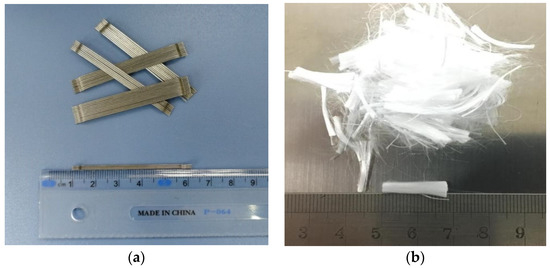
Figure 1.
Fibers employed in the experiment: (a) hooked-end steel fiber and (b) polypropylene fiber.

Table 2.
Characteristics of fibers.
2.2. Specimen Preparation
In order to investigate the effects of various fibers, single SF, single PF, and the cocktail of them were added to the fiber-reinforced SCC. Table 1 illustrates that the following seven mixtures are employed in the present study: two PF contents, three SF contents, and one hybrid fiber content. The mixture type is defined according to different fiber types and fiber dosages. Taking specimen SF40 as an example, the first two characters represent that the fiber type is steel fiber, and the digit 40 means the fiber dosage in mass is 40 kg/m3. Reference specimen NC (SCC without fibers) was also prepared for comparison. Moreover, cubic specimens with a side length of 150 mm and prismatic specimens with a size of 100 mm × 100 mm × 400 mm were prepared for the fire resistance tests and residual mechanical tests [47,48]. All the specimens were demolded after casting for 24 h and cured in water of temperature 20 ± 2 °C. In total, 126 cubic specimens and 84 prismatic specimens were tested.
According to EFNARC [49], the slump flow test, J-ring test, and L-box test were selected to evaluate the workability of the fresh fiber-reinforced SCC. The slump flow test and J-ring test are utilized for assessing the consistency and filling ability of the fresh concrete, while the L-box test is usually used to evaluate the passing ability and segregation resistance of fresh concrete.
2.3. Test Procedure
Figure 2 illustrates that fire resistance tests were carried out in an electric resistance furnace at a constant heating rate of 10 °C/min. Five target temperatures ranging from 200 °C to 1000 °C were applied for cubic specimens. Moreover, three target temperatures of 200 °C, 400 °C, and 600 °C were employed for prismatic specimens. Figure 3 demonstrates the temperature–time curves of the heating procedures. Specimens were kept in the furnace for 2 h after heating to the target temperature. Uniform temperature distribution inside the specimen could be obtained and then the specimens were cooled down naturally to room temperature.
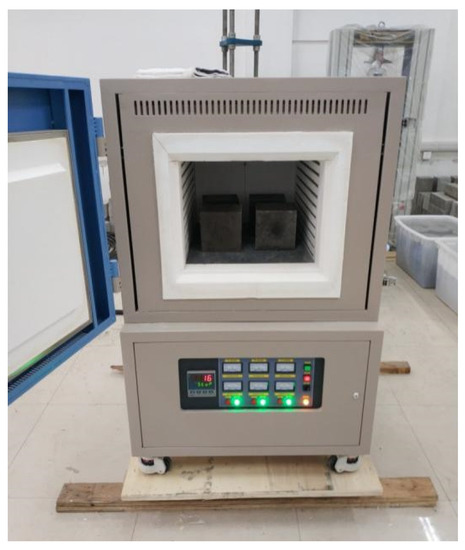
Figure 2.
Electric resistance furnace.
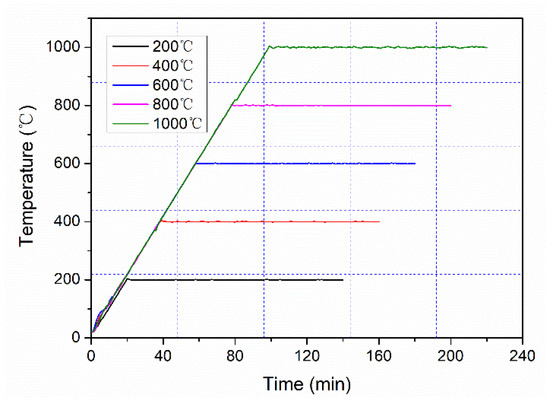
Figure 3.
Temperature–time curves for different target temperatures.
The spalling of the concrete specimen was evaluated by the naked eye after the fire resistance tests. The mass loss was also determined by measuring the weight of the specimens before and after the fire resistance test. Then, the compressive strength test and bending test were carried out to determine the residual mechanical properties after 2 days from heating/cooling procedures. Figure 4 and Figure 5 illustrate the test setups for compressive strength and bending strength.

Figure 4.
Compression test.
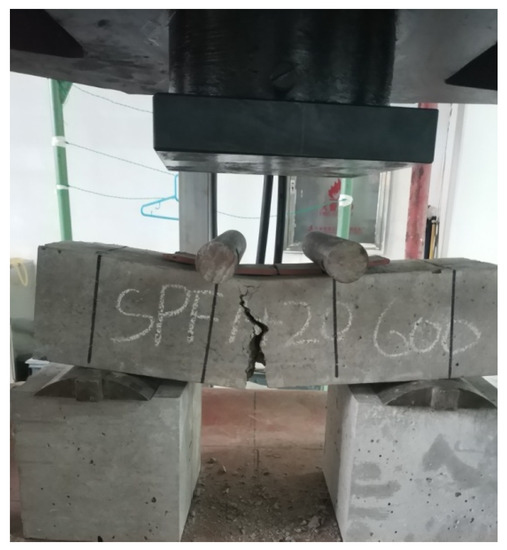
Figure 5.
Bending test.
3. Results and Discussion
In order to explore the influence of various fibers on the spalling resistance and residual mechanical properties of the fiber-reinforced SCC, a furnace test and residual strength test after heating to target temperatures were carried out. It should be indicated that the represented values are the average of data resulting from three tests at each target temperature.
3.1. Workability and Mechanical Properties of Fiber-Reinforced SCC at Ambient Temperature
In order to maintain the same water-to-binder ratio and an acceptable slump flow for SCC (slump flow of 60 cm), a larger volume of superplasticizer is used for the fiber-reinforced SCC, especially for mixtures containing PF, as illustrated in Table 1. Table 3 presents the workability test results of the fresh fiber-reinforced SCC and the mechanical properties of the hardened fiber-reinforced SCC at room temperature. Moreover, Figure 6 illustrates pictures of the workability test for fresh SCC. Table 3 and Figure 6 show that all parameters related to workability satisfy the SCC’s requirements in accordance with EFNARC [49].

Table 3.
Test results of workability and compressive strength of fiber-reinforced SCC.

Figure 6.
Workability of fiber-reinforced SCC: (a) slum flow; (b) J-ring; (c) L-box.
Table 3 shows that the fiber amounts utilized in the present study affect the compressive strength and flexural tensile strength. On the one hand, brittle concrete can be converted into a ductile material with the incorporation of different fibers. The inclusion of SF can slightly enhance the compressive strength of concrete at room temperature. In comparison to reference specimens, the compressive strength increases only by 5% after adding 50 kg/m3 SF in the concrete matrix, and no significant effect is observed with the combination of SF and PF. However, adding a single PF exhibits a negative effect on the compressive strength of SCC. On the other hand, incorporating SF can affect flexural tensile strength significantly. In comparison to plain SCC, adding 20 kg/m3, 40 kg/m3, and 50 kg/m3 SF to the concrete can increase the flexural tensile strength by 33%, 47%, and 42%, respectively. This is because the fibers’ contribution to the flexural tensile strength is dominated by the number of fibers crossing the crack rather than their weight. It should be indicated that the advantageous effect of SF on the tensile strength of the concrete is due to the sum of the tensile strength brought about by each fiber [50], while for specimens with PF, no significant impact on the flexural tensile strength can be observed.
3.2. Observation of the Explosive Spalling
Spalling of the specimen is not observed when it is in the electric resistance furnace. However, the occurrence of spalling can be recognized by the sound of spalling and the sound intensity during the heating procedure. It was observed that no spalling occurs in the cubic specimens when the test temperature is lower than 400 °C. This result was obtained from the heating procedure and after opening the furnace. However, for prismatic specimens made of SCC without fibers and specimens with relatively low dosages of SF, such as specimens SF20 and SF40, explosive spalling occurs. When the heating procedure began, explosive spalling of specimens NC, SF20, and SF40 occurred at the 38th, 42nd, and 43rd min, respectively. Figure 7 illustrates the explosive spalling of the prismatic specimens. No spalling was observed for all specimens with PF, including the cases of SCC with single PF or the combination of SF and PF. It is worth noting that this phenomenon is consistent with Han et al.’s findings [20]. However, regarding SF specimens, as the fiber content increased, the spalling depth and volume decreased gradually. When the fiber content increased to 50 kg/m3, no significant spalling was observed. This phenomenon can be illustrated by the fact that randomly dispersed SF in the concrete can bridge the internal cracks induced by high temperatures. Moreover, higher residual flexural tensile strength is observed in the following section. Therefore, the beneficial effect of the SF on the spalling behavior of SCC can be obtained.

Figure 7.
Explosive spalling of bending specimens after exposure to 400 °C: (a) NC; (b) SF20; (c) SF40.
Figure 8 shows that cubic specimens NC, SF20, and SF40 also suffer explosive spalling when the target temperature rises to 600 °C. Three NC specimens all suffered severe spalling to different extents. Although SF specimens suffered extensive spalling, not all three specimens suffered explosive spalling. This demonstrates that the addition of SF can help improve the fire resistance of the concrete. The spalling time mainly focuses on the periods from the 45th to the 53rd min after the heating process begins. Moreover, there is no significant spalling sound in the following constant temperature procedures. For bending specimens, they are almost the same as the cubic specimens in the case of spalling. However, the furnace test shows that specimen SF50 suffered significant explosive spalling and specimen SF40 suffered layered explosive spalling. Figure 9 illustrates that the peeling-off depth is 8 to 14 mm at the bottom of the beam.

Figure 8.
Explosive spalling of cubic specimens after exposure to 600 °C: (a) NC; (b) SF20; (c) SF40.
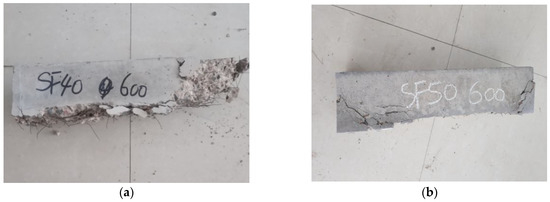
Figure 9.
Explosive spalling of bending specimens after exposure to the high temperature of 600 °C: (a) SF40 and (b) SF50.
It was found that for target temperatures of 800 °C and 1000 °C, spalling of the cubic specimens is similar to the case of specimens exposed to the high temperature of 600 °C. The spalling of the specimens occurs almost at the 51st to 63rd min from the beginning of the heating process, and severe spalling sounds were heard. It should be indicated that the sound intensified and then a great explosion occurred. Then, the spalling sound reduced sharply. Figure 10 shows the layered color of the steel-fiber-reinforced specimens after exposure to the high temperature of 1000 °C. It was observed that the layer depth from the outmost fiber of the specimen is about 55 to 65 mm. Moreover, Figure 10b illustrates that SF was severely oxidized, and almost no complete SF exists in the concrete. From the residual strength test results illustrated in the next section, it was found that nearly no strength can be reserved after heating to 1000 °C.
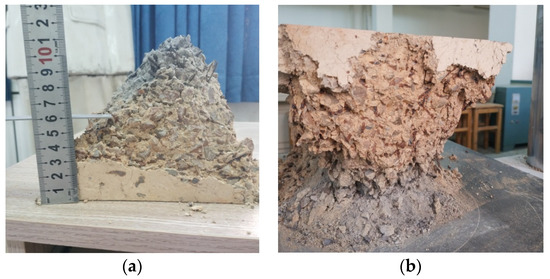
Figure 10.
Layered color of cubic specimens after heating to the target temperature of 1000 °C: (a) SF20 and (b) SF50.
In summary, the SCC’s explosive spalling resistance can be effectively enhanced with the incorporation of fibers, especially for the inclusion of PF in the form of a single PF or combined with SF. On the one hand, it is beneficial from the uniform distribution of PF in the concrete matrix and lower melting temperature (165–173 °C). When the melting temperature of PF is exceeded, interconnected channels left by the melting PF are favorable for mitigating interior vapor stress, which can help enhance the explosive spalling resistance of the concrete [22]. On the other hand, the thermal mismatch between the polypropylene fibers and the matrix results in an interconnected network of cracks in the matrix even before melting of the polypropylene fibers [38,51]. It is worth noting that for specimens with the addition of the single SF, explosive spalling still exists when the fiber content is relatively low. When more SF is used in the specimens, for example in specimen SF50, little spalling is found in the specimens after heating to the temperature of 600 °C. SF can bridge the microcracks induced by high temperature and transfer the stress from the concrete matrix to SF by the interfacial bond, which can help restrict the propagation of the cracks in the concrete matrix. However, the restriction effect is weaker with lower fiber contents, thus higher contents of SF are required for enhancing the explosive spalling resistance of the concrete. For cocktail fiber specimens blended with SF and PF, for example, specimen SPF201, reasonable explosive spalling resistance can be obtained even with relatively low fiber content, which can be a bright material for reducing the explosive spalling of SCC at elevated temperatures.
3.3. Residual Compressive Strength
The residual compressive strength of the concrete is the most important characteristic that should be considered in assessing the post-fire response of concrete structures. Therefore, the compressive strength tests were initially performed by loading the cubic specimens to failure after heating to various target temperatures. Figure 11 and Table 4 show that the residual compressive strength of the SCC specimens without and with fibers is compared with different target temperatures. It is observed that there is a key temperature of 400 °C for SCC without and with fibers, which divides the temperature effect on the compressive strength into two parts. Firstly, when the target temperature is lower than 400 °C, no significant influence of the temperature on the compressive strength is observed. Figure 11a shows that a slight increase in the compressive strength is observed in plain and steel fiber-reinforced SCC compared to specimens under room temperature. This phenomenon can be explained as follows: (i) Free water and chemically bound water disappear at about 200–300 °C [52], which makes the microstructure of the concrete more porous. (ii) High temperatures can promote the hydration progress of the unhydrated cement particles that exist in the concrete matrix because of the low water-to-binder ratio of SCC, which continues to hydrate and increase the density of the matrix. (iii) Calcium hydroxide (CH), a hydration production of cement, reacts with active silica in fly ash and produces more calcium silicate hydrate (C-S-H). This can help fill the pores and microcracks induced by increased vapor pressure build-up under high temperatures inside the concrete matrix. Considering the comprehensive effects of the abovementioned complex physical and chemical changes, a strengthened concrete matrix is obtained. It is worth noting that for SF mixtures, the compressive strength is enhanced with the inclusion of SF. The favorable impact of SF on the compressive strength of the concrete is obtained when the temperature is lower than 400 °C. This is because higher thermal conductivity allows the steel fiber-reinforced SCC to quickly dissipate heat in a much larger volume than in plain SCC. In the case of PF, there is no clear effect of the cocktail fiber blended with SF and PF on the residual compressive strength. Figure 11b illustrates that the incorporation of a single PF shows a negative effect on the residual compressive strength of the concrete. This is because PF melts leave microscopic channels inside the concrete matrix, which causes a great increase in the concrete’s porosity and induces a great decrease in the residual compressive strength.
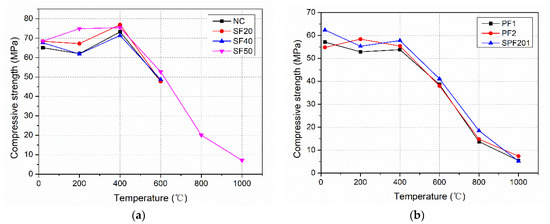
Figure 11.
Residual compressive strength of the fiber-reinforced SCC subjected to different high temperatures: (a) SF and (b) PF + SPF.

Table 4.
Residual compressive strength of the fiber-reinforced SCC after heating to various target temperatures.
Secondly, Figure 11 demonstrates that when heated to temperatures above 400 °C, whenever a single fiber or fiber cocktail blended with PF and SF is incorporated into the concrete matrix, the residual compressive strength decreases significantly. This is because the temperature damage on the concrete matrix has begun, such as decomposition of C-S-H, and significant cracks propagate in specimens. In this circumstance, the fiber’s favorable effect for enhancing the residual compressive strength is far less than the effect of the temperature damage on the heated SCC. For example, in comparison to the compressive strength at room temperature, only 24–30% of that is reserved after heating to the temperature of 800 °C. When the target temperature reaches 1000 °C, almost all of the compressive strength is lost and only approximately 10% of the compressive strength is retained. These results are confirmed by the findings of other researchers [12,35].
Finally, Figure 11b illustrates that the cocktail fiber specimens can preserve higher residual compressive strength in comparison with PF specimens. This is because SF with a high melting temperature of 1370 °C is incorporated in the cocktail fiber specimens, which does not melt and remains inside the concrete after high-temperature exposure. Therefore, adding SF in the cocktail fiber specimens plays a significant role in preserving the high residual strength of the concrete after heating to high temperatures.
In order to satisfy the workability requirements of the fresh SCC, the steel fiber content is restricted and it is usually less than 60 kg/m3 [53]. In this circumstance, the influence of the steel fiber content on the compressive strength of concrete is marginal. Based on the regression analysis, the reduction factor of the compressive strength of the fiber-reinforced SCC at elevated temperatures can be mathematically expressed as follows:
For SF-SCC:
For PF-SCC:
where kc(θ) and T denote the reduction coefficient of the compressive strength, kc(θ) = fcuT/fcu20 and the test temperature, °C, respectively.
Figure 12 shows the comparison of the reduction coefficient with test data in the present study and predicted equations in EC2 [26] and the study of Aslani [54] and the abovementioned model. Figure 12 illustrates that the proposed model is more suitable for estimating fiber-reinforced SCC’s residual compressive strength under various high temperatures.
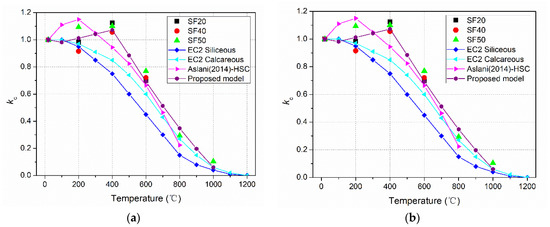
Figure 12.
Reduction coefficient for residual compressive strength of fiber-reinforced SCC at different temperatures: (a) SF-SCC and (b) PF-SCC.
3.4. Residual Flexural Tensile Strength
Residual flexural tensile strength of the concrete is another key parameter governing the behavior of the fiber-reinforced SCC after heating to high temperatures. It should be indicated that flexural tensile strength tests are performed on the prismatic specimens after the fire resistance test. Figure 13 and Table 5 present that residual flexural tensile strength of SCC specimens without and with fibers is compared with varying target temperatures. It is observed that specimens with SF maintain higher residual flexural tensile strength in comparison to plain specimens without fibers. This is mainly because of the bridging effect of randomly dispersed SF cross cracks existing inside the concrete. However, for specimens with a single PF, no clear impact on the residual flexural tensile strength was observed. This may be attributed to the melting of PF and the formation of interconnected pores. Regarding combined fiber-reinforced specimens consisting of PF and SF, a great increase in residual flexural tensile strength compared with plain specimens was observed. The inclusion of SF plays a key role in enhancing the residual flexural tensile strength after PF has melted.

Figure 13.
Flexural tensile strength of fiber-reinforced SCC subjected to different temperatures: (a) SF and (b) PF + SPF.

Table 5.
Residual flexural tensile strength of the fiber-reinforced SCC after heating to different high temperatures.
In the present study, for specimens with SF, there is a critical temperature of 200 °C influencing the residual flexural tensile strength. When the temperatures are lower than 200 °C, the residual flexural tensile strength of the concrete can be increased significantly with the incorporation of SF. The more SF used in concrete, the higher the residual flexural tensile strength obtained. For instance, Figure 13a shows that in comparison to the flexural tensile strength at room temperature, the inclusion of 20 kg/m3, 40 kg/m3, and 50 kg/m3 SF can enhance the flexural tensile strength of fiber-reinforced SCC by 6%, 7%, and 15%, respectively, after heating to the high temperature of 200 °C. However, when the target temperatures were beyond the temperature of 200 °C, unlike the slower loss of compressive strength, a sharp reduction in the residual flexural tensile strength was observed. It is observed that the tensile strength of the concrete shows higher sensitivity to cracks induced by high temperature to concrete, whether on a macroscale or a microscale [54,55]. Regarding specimens incorporating single PF or cocktail fibers, Figure 14b shows that no critical temperature exists, while a significant reduction in the residual flexural tensile strength is obtained as the target temperatures increase. After heating to the high temperature of 600 °C, only 17% to 25% of the flexural tensile strength of all the fiber-reinforced SCC specimens at room temperature is reserved.

Figure 14.
Comparison of reduction coefficient for residual flexural tensile strength of fiber-reinforced SCC at elevated temperatures: (a) SF-SCC and (b) PF-SCC.
In summary, as demonstrated in Figure 13, regarding the ability of concrete types in preserving the residual flexural tensile strength, SF specimens show the best performing concrete types, which are followed by the cocktail fiber specimens and then followed by PF specimens and plain specimens. The incorporation of SF in the concrete plays a significant role in preserving the residual mechanical properties. However, because of the low melting temperatures of PF, the melting and vaporizing of them occurs in heating procedures. Consequently, no evident influence on the residual strength is obtained with the inclusion of PF.
Compared with the target temperature, the effect of fiber content on the residual flexural tensile strength after exposure to elevated temperatures is little. Based on the regression analysis, the reduction coefficient for the residual flexural tensile strength of fiber-reinforced SCC at elevated temperature can be mathematically expressed as follows:
For SF-SCC:
For PF-SCC:
where kfr(θ) and T denote the reduction coefficient of the flexural strength of fiber-reinforced SCC, kfr(θ) = frT/fr20 and the test temperature, °C, respectively.
Figure 14 presents the comparison of the reduction coefficient to test data in the present study and the equation proposed in the study of Aslani [54] and the abovementioned Equation (2). Figure 14 shows that the proposed model is more suitable for predicting the residual flexural tensile strength of fiber-reinforced SCC at elevated temperatures.
3.5. Mass Loss
Figure 15 illustrates the mass loss of compressive and bending specimens after heating to various high temperatures. It is observed that there is no significant effect on the mass loss of plain and fiber-reinforced SCC after heating to high temperatures. Moreover, similar trends can be observed by incorporating or not incorporating fibers. However, the mass loss increases significantly as the target temperatures increase. This phenomenon illustrates that the temperature damage in the concrete dominates the mass loss of SCC, and the fiber’s effect is marginal. Figure 15a shows that for cubic specimens, after exposure to the high temperature of 600 °C, 8–10% mass loss is obtained. Figure 15b shows that a similar trend for bending specimens is observed, except for the specimen with the addition of 50 kg/m3 SF. Relatively high fiber content can help enhance the explosive spalling resistance of the concrete, which may explain the reason for the exception.
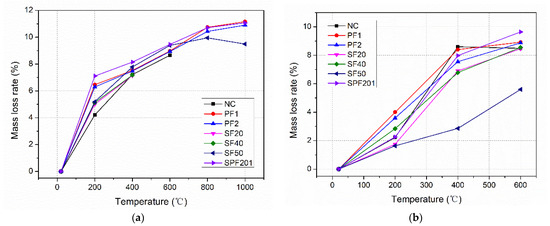
Figure 15.
Mass loss of specimens after heating to various high temperatures: (a) compression specimens and (b) bending specimens.
4. Conclusions
In the present study, an experimental investigation was carried out to explore the effect of various fibers on the spalling resistance, residual mechanical properties, and physical properties of self-compacting concrete (SCC) after heating to an elevated temperatures. The following conclusions can be drawn:
- Steel fiber affects the workability of the concrete marginally up to a fiber dosage of 50 kg/m3. However, the polypropylene fiber used in the present study has a negative impact on workability, and a large volume of superplasticizer should be utilized to preserve the same water-to-binder ratio and a proper slump flow for SCC.
- At ambient temperature, steel fiber with dosages ranging from 20 kg/m3 to 50 kg/m3 had little effect on the compressive strength, while a great increase of up to 47% was observed for the flexural tensile strength of SCC. Moreover, for polypropylene fiber with dosages of 1 kg/m3 and 2 kg/m3, there was no clear impact on the flexural tensile strength of SCC, while a negative effect (15% reduction) on the compressive strength of SCC was obtained.
- The inclusion of polypropylene fiber can effectively reduce the spalling of concrete even with a low dosage of 1 kg/m3. Referring to steel fiber specimens, the spalling resistance of concrete can be improved, while relatively high fiber content (e.g., 50 kg/m3) is recommended. A temperature of 400 °C was found to be a key heating level for the residual compressive strength of SCC without and with fibers.
- Elevated temperatures were found to be more detrimental to the flexural tensile strength of all mixtures. When the target temperature was above 200 °C, a significant decrease in the residual flexural tensile strength of the plain and fiber-reinforced SCC was observed. Moreover, steel fiber was found to be more effective than polypropylene fiber in enhancing the residual flexural tensile strength of concrete.
- The incorporation of cocktail fibers blended with 20 kg/m3 steel fiber and 1 kg/m3 polypropylene fiber in SCC well satisfies the workability requirements of the fresh SCC. No explosive spalling and less degradation of mechanical properties were observed in specimen SPF201 after exposure to various high temperatures. The mixed fibers exhibit a promising way to improve the fire resistance feature of SCC.
- Based on the regression analysis, correlations between residual strength and elevated temperature are proposed. A comparison of the equations of reduction coefficient in the literature and the present study illustrates that the proposed equation is more suitable for predicting the residual strength of the fiber-reinforced SCC at elevated temperatures.
Author Contributions
Conceptualization, X.N. and Y.L.; methodology, X.N. and J.L.; software, X.N. and J.L.; validation, X.N., J.L. and Y.L.; formal analysis, X.N.; investigation, X.N. and J.L.; resources, X.N.; data curation, J.L. and Y.L.; writing—original draft preparation, X.N., J.L. and Y.L.; writing—review and editing, X.N. and J.L.; visualization, X.N. and Y.L.; supervision, X.N., J.L. and Y.L. All authors have read and agreed to the published version of the manuscript.
Funding
This research was funded by the National Natural Science Foundation of China (Project No. 51608100) and Science and Technology Project of Jilin Province Education Department (Project No. JJKH20220121KJ).
Institutional Review Board Statement
Not applicable.
Informed Consent Statement
Not applicable.
Data Availability Statement
The data presented in this study are available on request from the corresponding author. The data are not publicly available as the data also form part of an ongoing study.
Conflicts of Interest
The authors declare no conflict of interest.
References
- Okamura, H.; Ozawa, K.; Ouchi, M. Self-compacting concrete. Struct. Concr. 2000, 1, 3–17. [Google Scholar] [CrossRef]
- Domone, P.L. Self-compacting concrete: An analysis of 11 years of case studies. Cem. Concr. Compos. 2006, 28, 197–208. [Google Scholar] [CrossRef]
- Okamura, H.; Ouchi, M. Self-compacting concrete. J. Adv. Concr. Technol. 2003, 1, 5–15. [Google Scholar] [CrossRef]
- Domone, P.L. A review of the hardened mechanical properties of self-compacting concrete. Cem. Concr. Compos. 2007, 29, 1–12. [Google Scholar] [CrossRef]
- Ning, X.; Ding, Y.; Zhang, F.; Zhang, Y. Experimental Study and Prediction Model for Flexural Behaviour of Reinforced SCC Beam Containing Steel Fibers. Constr. Build. Mater. 2015, 93, 644–653. [Google Scholar] [CrossRef]
- Ferrara, L.; Park, Y.-D.; Shah, S.P. A method for mix-design of fiber-reinforced self-compacting concrete. Cem. Concr. Res. 2007, 37, 957–971. [Google Scholar] [CrossRef]
- Ashish, D.K.; Verma, S.K. An overview on mixture design of self-compacting concrete. Struct. Concr. 2019, 20, 371–395. [Google Scholar] [CrossRef]
- Le, H.T.; Müller, M.; Siewert, K.; Ludwig, H.-M. The mix design for self-compacting high performance concrete containing various mineral admixtures. Mater. Des. 2015, 72, 51–62. [Google Scholar] [CrossRef]
- Noumowé, A.; Carré, H.; Daoud, A.; Toutanji, H. High-strength self-compacting concrete exposed to fire test. J. Mater. Civ. Eng. ASCE 2006, 18, 754–758. [Google Scholar] [CrossRef]
- Haddad, R.H.; Odeh, R.A.; Amawi, H.A.; Ababneh, A.N. Thermal performance of self-compacting concrete: Destructive and nondestructive evaluation. Can. J. Civ. Eng. 2013, 40, 1205–1214. [Google Scholar] [CrossRef]
- Persson, B. Fire resistance of self-compacting concrete, SCC. Mater. Struct. 2004, 37, 575–584. [Google Scholar] [CrossRef]
- Mugume, R.B.; Horiguchi, T. Prediction of spalling in fibre-reinforced high strength concrete at elevated temperatures. Mater. Struct. 2014, 47, 591–604. [Google Scholar] [CrossRef]
- Hertz, K.D. Limits of spalling of fire-exposed concrete. Fire Saf. J. 2003, 38, 103–116. [Google Scholar] [CrossRef]
- Kodur, V.; Phan, L. Critical factors governing the fire performance of high strength concrete systems. Fire Saf. J. 2007, 42, 482–488. [Google Scholar] [CrossRef]
- Jansson, R.; Boström, L. Factors influencing fire spalling of self-compacting concrete. Mater. Struct. 2013, 46, 1683–1694. [Google Scholar] [CrossRef]
- Phan, L.T. Pore pressure and explosive spalling in concrete. Mater. Struct. 2008, 41, 1623–1632. [Google Scholar] [CrossRef]
- Fu, Y.; Li, L. Study on mechanism of thermal spalling in concrete exposed to elevated temperatures. Mater. Struct. 2011, 44, 361–376. [Google Scholar] [CrossRef]
- Liu, J.; Tan, K.H.; Yao, Y. A new perspective on nature of fire-induced spalling in concrete. Constr. Build. Mater. 2018, 184, 581–590. [Google Scholar] [CrossRef]
- Kalifa, P.; Chene, G.; Galle, C. High-temperature behaviour of HPC with polypropylene fibres: From spalling to microstructure. Cem. Concr. Res. 2001, 31, 1487–1499. [Google Scholar] [CrossRef]
- Han, C.G.; Hwang, Y.-S.; Yang, S.-H.; Gowripalan, N. Performance of spalling resistance of high performance concrete with polypropylene fiber contents and lateral confinement. Cem. Concr. Res. 2005, 35, 1747–1753. [Google Scholar] [CrossRef]
- Zeiml, M.; Leithner, D.; Lackner, R.; Ang, H.A. How do polypropylene fibers improve the spalling behavior of in-situ concrete? Cem. Concr. Res. 2006, 36, 929–942. [Google Scholar] [CrossRef]
- Liu, X.; Ye, G.; De Schutter, G.; Yuan, Y.; Taerwe, L. On the mechanism of polypropylene fibres in preventing fire spalling in self-compacting and high performance cement paste. Cem. Concr. Res. 2008, 38, 487–499. [Google Scholar] [CrossRef]
- Eidan, J.; Rasoolan, I.; Rezaeian, A.; Poorveis, D. Residual mechanical properties of polypropylene fiber-reinforced concrete after heating. Constr. Build. Mater. 2019, 198, 195–206. [Google Scholar] [CrossRef]
- Sideris, K.; Manita, P. Residual mechanical characteristics and spalling resistance of fiber-reinforced self-compacting concretes exposed to elevated temperatures. Constr. Build. Mater. 2013, 41, 296–302. [Google Scholar] [CrossRef]
- Sadrmomtazi, A.; Gashti, S.H.; Tahmouresi, B. Residual strength and microstructure of fiber reinforced self-compacting concrete exposed to high temperatures. Constr. Build. Mater. 2020, 230, 116969. [Google Scholar] [CrossRef]
- EN1992-1-2, 2004b; Eurocode 2: Design of Concrete Structures. Part 1–2: General Rules—Structural Fire Design. Commission of European Communities: Brussels, Belgium, 2004.
- ACI Committee 544. Design Considerations for Steel Fiber-Reinforced Concrete; American Concrete Institute: Farmington Hills, MI, USA, 1999. [Google Scholar]
- Olivito, R.S.; Zuccarello, F.A. An experimental study on the tensile strength of steel fiber-reinforced concrete. Compos. Pt. B-Eng. 2010, 41, 246–255. [Google Scholar] [CrossRef]
- Ding, Y.; Azevedo, C.; Aguiar, J.; Jalali, S. Study on residual behaviour and flexural toughness of fibre cocktail reinforced self-compacting high performance concrete after exposure to high temperature. Constr. Build. Mater. 2012, 26, 21–31. [Google Scholar] [CrossRef]
- Khaliq, W.; Kodur, V. Thermal and mechanical properties of fiber-reinforced high performance self-consolidating concrete at elevated temperatures. Cem. Concr. Res. 2011, 41, 1112–1122. [Google Scholar] [CrossRef]
- Zhang, P.; Kang, L.; Wang, J.; Guo, J.; Hu, S.; Ling, Y. Mechanical Properties and Explosive Spalling Behavior of Steel-Fiber-Reinforced Concrete Exposed to High Temperature-A. Review. Appl. Sci. 2020, 10, 2324. [Google Scholar] [CrossRef]
- Poon, C.; Shui, Z.; Lam, L. Compressive behaviour of fibre reinforced high-performance concrete subjected to elevated temperatures. Cem. Concr. Res. 2004, 34, 2215–2222. [Google Scholar] [CrossRef]
- Lau, A.; Anson, M. Effect of high temperatures on high performance steel fibre reinforced concrete. Cem. Concr. Res. 2006, 36, 1698–1707. [Google Scholar] [CrossRef]
- Colombo, M.; di Prisco, M.; Felicetti, R. Mechanical properties of steel fibre reinforced concrete exposed at high temperatures. Mater. Struct. 2010, 43, 475–491. [Google Scholar] [CrossRef]
- Ponikiewski, T.; Katzer, J.; Kilijanek, A.; Kuźmińska, E. Mechanical behaviour of steel fibre reinforced SCC after being exposed to fire. Adv. Concr. Constr. 2018, 6, 631–643. [Google Scholar]
- Wang, D.; Ju, Y.; Shen, H.; Xu, L. Mechanical properties of high performance concrete reinforced with basalt fiber and polypropylene fiber. Constr. Build. Mater. 2019, 197, 464–473. [Google Scholar] [CrossRef]
- Ding, Y.; Zhang, Y.; Thomas, A. The investigation on strength and flexural toughness of fibre cocktail reinforced self-compacting high performance concrete. Constr. Build. Mater. 2009, 23, 448–452. [Google Scholar] [CrossRef]
- Li, Y.; Tan, K.H.; Yang, E.-H. Synergistic effects of hybrid polypropylene and steel fibers on explosive spalling prevention of ultra-high performance concrete at elevated temperature. Cem. Concr. Compos. 2019, 96, 174–181. [Google Scholar] [CrossRef]
- Serrano, R.; Cobo, A.; Prieto, M.I.; de las Nieves González, M. Analysis of fire resistance of concrete with polypropylene or steel fibers. Constr. Build. Mater. 2016, 122, 302–309. [Google Scholar] [CrossRef]
- Yan, Z.; Shen, Y.; Zhu, H.; Li, X.; Lu, Y. Experimental investigation of reinforced concrete and hybrid fibre reinforced concrete shield tunnel segments subjected to elevated temperature. Fire Saf. J. 2015, 71, 86–99. [Google Scholar] [CrossRef]
- Hou, X.; Ren, P.; Rong, Q.; Zheng, W.; Zhan, Y. Comparative fire behavior of reinforced RPC and NSC simply supported beams. Eng. Struct. 2019, 185, 122–140. [Google Scholar] [CrossRef]
- Peng, G.F.; Yang, W.W.; Zhao, J.; Liu, Y.F.; Bian, S.H.; Zhao, L.H. Explosive spalling and residual mechanical properties of fiber-toughened high-performance concrete subjected to high temperatures. Cem. Concr. Res. 2006, 36, 723–727. [Google Scholar] [CrossRef]
- Ozawa, M.; Morimoto, H. Effects of various fibres on high-temperature spalling in high-performance concrete. Constr. Build. Mater. 2014, 71, 83–92. [Google Scholar] [CrossRef]
- Varona, F.B.; Baeza, F.J.; Bru, D.; Ivorra, S. Influence of high temperature on the mechanical properties of hybrid fibre reinforced normal and high strength concrete. Constr. Build. Mater. 2018, 159, 73–82. [Google Scholar] [CrossRef]
- Yermak, N.; Pliya, P.; Beaucour, A.-L.; Simon, A.; Noumowé, A. Influence of steel and/or polypropylene fibres on the behaviour of concrete at high temperature: Spalling, transfer and mechanical properties. Constr. Build. Mater. 2017, 132, 240–250. [Google Scholar] [CrossRef]
- Pliya, P.; Beaucour, A.; Noumowé, A. Contribution of cocktail of polypropylene and steel fibres in improving the behaviour of high strength concrete subjected to high temperature. Constr. Build. Mater. 2011, 25, 1926–1934. [Google Scholar] [CrossRef]
- CECS 13: 2009; Standard Test Methods for Fiber Reinforced Concrete. China Planning Press: Beijing, China, 2010. (In Chinese)
- ASTM C1609/C1609M; Standard Test Method for Flexural Performance of Fiber Reinforced Concrete (Using Beam with Third-Point Loading). ASTM International: West Conshohocken, PA, USA, 2019.
- EFNARC. Specification and guidelines for self-compacting concrete. In European Federation of Specialist Construction Chemicals and Concrete System; Association House: Surrey, UK, 2002. [Google Scholar]
- di Prisco, M.; Plizzari, G.; Vandewalle, L. Fibre reinforced concrete: New design perspectives. Mater. Struct. 2009, 42, 1261–1281. [Google Scholar] [CrossRef]
- Zhang, D.; Dasari, A.; Tan, K.H. On the mechanism of prevention of explosive spalling in ultra-high performance concrete with polymer fibers. Cem. Concr. Res. 2018, 113, 169–177. [Google Scholar] [CrossRef]
- Ma, Q.; Guo, R.; Zhao, Z.; Lin, Z.; He, K. Mechanical properties of concrete at high temperature-A review. Constr. Build. Mater. 2015, 93, 371–383. [Google Scholar] [CrossRef]
- Ding, Y.; You, Z.; Jalali, S. The composite effect of steel fibres and stirrups on the shear behaviour of beams using self-consolidating concrete. Eng. Struct. 2011, 33, 107–117. [Google Scholar] [CrossRef]
- Aslani, F.; Samali, B. Constitutive relationships for steel fibre reinforced concrete at elevated temperatures. Fire Technol. 2014, 50, 1249–1268. [Google Scholar] [CrossRef]
- Bamonte, P.; Felicetti, R. High-Temperature Behaviour of Concrete in Tension. Struct. Eng. Int. 2012, 22, 493–499. [Google Scholar] [CrossRef]
Publisher’s Note: MDPI stays neutral with regard to jurisdictional claims in published maps and institutional affiliations. |
© 2022 by the authors. Licensee MDPI, Basel, Switzerland. This article is an open access article distributed under the terms and conditions of the Creative Commons Attribution (CC BY) license (https://creativecommons.org/licenses/by/4.0/).